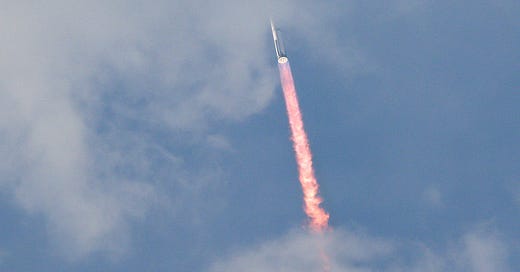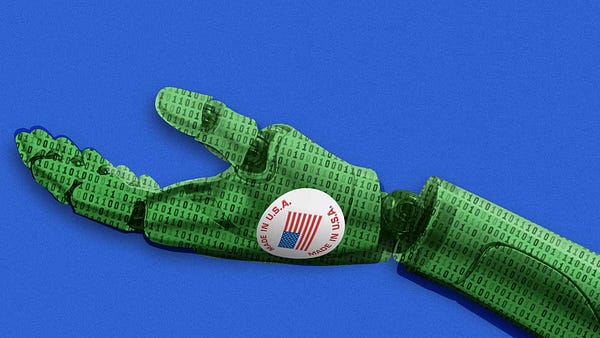
The Free Press

Here’s a story my future grandchildren are going to hear from me more than once: I was on South Padre Island on April 20, 2023, when SpaceX launched its Starship for the very first time from Boca Chica Beach. It will be essential that they hear it from me, though, because this is how it was reported by the press at the time:
Was the SpaceX launch really a “success”?
Elon Musk’s Explosive Day: First SpaceX blew up a rocket. Then Musk blew up Twitter’s verification system.
Elon Musk’s Wealth Plunges $13 Billion as Drama Unfolds Across Empire: In the span of 24 hours, Tesla’s earnings disappointed, a SpaceX rocket exploded, and Twitter purged legacy blue checkmarks.
It’s No Surprise SpaceX Blows Up Rockets in Texas. That’s Why It Came Here.
SpaceX’s Starship blew up after launch—it also caused “catastrophic” damage on the ground
SpaceX celebrated Starship’s first launch. Some locals called it “truly terrifying”
The energy on the island was euphoric that day—the fire warming our faces, the tremendous roar of 33 rocket engines, the cheers on the beach—which made reading such headlines all the more jarring.
It was true, of course, that the rocket spun out of control and blew up. In SpaceX lingo it experienced a RUD, or “Rapid Unscheduled Disassembly.” The RUD occurred about four minutes into the test, before the Starship spacecraft had a chance to separate from its massive “Super Heavy” rocket booster.
It was also true that Tesla stock went down, and that a number of journalists incidentally lost their blue checks on Twitter that day and had to pay $8 to get them back. It was true that politicians in the area complained about how loud the rocket was, and that the fire from dozens of massive rocket engines made a mess on the beach.
But amid all the “literally true” statements, the press completely missed the point. While journalists were rushing to figure out their angle of attack—many opted to focus on their personal dislike for Musk—the SpaceX team was rushing to figure out what had worked, and what went wrong. It was later determined that a series of smaller explosions had destroyed several engines, initiating the rocket’s self-destruct system. That system malfunctioned for forty seconds while the rocket did somersaults high in the sky, until eventually completing the self-destruct.
Failure is, as those who’ve tried something hard know, a stone on the road to success. For SpaceX in particular, it was the company’s keystone strategy for the past twenty years: learn from iterating quickly on failures until you can repeat success.
That strategy worked magnificently. Recall that in 2008, SpaceX was a fledgling company; its first three launch attempts, from 2006 to 2008, of its first rocket, Falcon 1, were all failures. No private company had ever successfully launched a rocket before. But the lessons from those three failures enabled the SpaceX team to successfully launch the Falcon 1 on the fourth try. Sixteen years later, SpaceX Falcons are the most launched American rockets in history, with hundreds of consecutive successes. The Falcon 9 Full Thrust has been launched 309 times—with no failures. Zero.
If you knew that story, would you think that the inaugural Starship launch was an unmitigated disaster because it didn’t function perfectly right away?
As we saw on Thursday, eleven months after that “failed” first launch, Starship made it to space at orbital speed. Stage separation has been successful twice now. SpaceX tested opening the Starship’s cargo doors and has laid the groundwork for in-orbit fuel transfers, which are important for deep space missions. The Super Heavy booster reentered the atmosphere before an RUD 1500 feet over the Gulf of Mexico. The Starship connected to SpaceX’s own satellite internet network while it was hurtling violently around the Earth so that it could livestream its flight through a plasma field to millions of viewers. Please read the previous sentence again.
RUDs and all, the third launch of Starship—just one of seven planned launches for 2024—is the most exciting moment for American space in years. Consider: it is the largest rocket system ever built. It will land Americans back on the moon for the first time in more than 50 years as a part of NASA’s Artemis program. It has the power to take us to Mars and beyond. It can cement American dominance in the twenty-first-century space race. And it just made it to space for the first time.
So don’t let any sour punditry confuse you. What happened in Texas last week is a man-made miracle—emphasis on man-made, because it took the men and women of SpaceX 20 years to build a sustainable company that could pull off such a feat.
Oh, and billions of dollars of cash.
To build rockets, especially big rockets, you need money. Lots of it. NASA gets it from Congress—about $25 billion a year. SpaceX didn’t have money from Uncle Sam at the beginning. It had to raise money from private investors—about $10 billion since 2002.
In 2024, the company projects billions in profits from two major revenue sources: launching rockets for commercial and government clients, and providing internet via Starlink satellites.
SpaceX has won an effective monopoly on space launches in the West by making them much cheaper and more reliable thanks to reusable rockets. The company launches the outright majority of worldwide material to orbit—that’s mostly commercial satellites and cargo for the International Space Station, though Elon Musk did once launch his personal Tesla Roadster sports car as well (it passed Mars in October 2020 and will swing past Earth in 2047). Outside of Russia and China, SpaceX accounted for over 99.9 percent of material sent to orbit at the end of 2023. The Falcon Heavy has achieved a cargo-cost-per-kilogram of just $1,500, about a quarter of the closest Chinese competitor.

But if the Starship program meets its goal of full reusability, the cargo-cost-per-kilogram could be just ten dollars. The implications of this number are profound. Just think what happened as computers became 99 percent cheaper over time: what used to fill up a room and cost a fortune now fits in our pocket and is accessible to billions of people. When it becomes dramatically cheaper to get heavy things into space, a new paradigm opens up: we can build orbital factories to take advantage of microgravity for manufacturing, or move a lot of mass to the moon or to Mars—enough to start a colony some day. The cost of cargo on Starship could be so low that the Air Force has contracted SpaceX to explore using Starship for military cargo flights to anywhere on Earth in under one hour.
But SpaceX’s surge to profitability in the last year was driven by soaring revenues from its Starlink internet. Starlink is now the world’s largest satellite constellation with over 5,500 satellites in orbit and growing—all launched by SpaceX’s own rockets, of course. Those satellites can provide high-speed internet on nearly the entire surface of the earth, including the Arctic. That makes Starlink indispensable for the military, airplanes, and people in remote locations.
On a private jet or airliner, Starlink costs hundreds of thousands of dollars to set up and tens of thousands of dollars per month for internet service. SpaceX also provides a military-grade version of Starlink—Starshield—to the Pentagon. The company projects Starlink internet revenue of about $10 billion in 2024, double the projected launch revenue.
Those dollars help pay for the crazy, inspiring stuff before it’s proven technology.
Being a private company was and is SpaceX’s greatest hurdle and also its greatest advantage. SpaceX’s early investors, engineers, and executives have made a great deal of money because the company succeeded, but that wasn’t inevitable. The company had to fight for its survival.
That fight made it strong. SpaceX could fail and improve publicly in ways that NASA cannot. NASA faces pressure from Congress to never mess up—get it perfect on the first try!—or a congressional hearing will be called and budgets cut. Can you imagine the showboating questions if NASA launched a sports car into space for fun?
Today, after 22 years, SpaceX is not just a $175 billion company; it’s the world’s largest space-launch entity by far, bigger than the combined governments of the world that had a 50-year head-start.
NASA still inspires Americans, but there should be no doubt as to why America is dominating in outer space today. It’s because we have SpaceX, too.
South Texas wasn’t on anyone’s radar as the place where we’d end the decades-long American slump in the space game. South Padre Island was historically a fishing village and cheap-o resort town. And as anyone who has spent time relaxing on a Texas beach knows, we aren’t giving Waikiki or Malibu a run for their money anytime soon.
The SpaceX Starbase on Boca Chica Beach, where the “ships” are assembled and launched, is just a few hundred yards from Mexico. Beside the 300-foot “high bay” is an eclectic settlement—mobile homes (one of them Elon Musk’s abode), Airstream campers, Tesla vehicles, and turf lawns and artificial plants to survive the muggy Texas summer. You can tell it was put together quickly. It’s a frontier bivouac. It’s unmistakably Texas.
Last year, after the glorious four-minute flight and subsequent acrobatics and RUD, as thousands were streaming toward the tiki bars and hotel pools of South Padre to start the post-launch party, I met two Canadians sitting in lawn chairs outside their pickup truck and Wildwood camper. They offered me and my travel partner some watermelon and we got to talking. I learned that they had made the 30-hour drive from Ontario to South Texas every spring for over three decades. They were astounded by the transformation of the place over that period. How couldn’t they be?
Those Canadians had a front-row seat to one of the greatest stories of all time—one of the most American stories of all time. It’s a story of “down but not out,” how the American space dream waned and was reignited by an unexpected group of people.
It’s the story of how an old fishing village and budget resort town became the place where we Americans fulfilled our greatest aspiration as a nation: to, as F. Scott Fitzgerald wrote a century ago, “run faster, stretch out our arms farther. . . ”
To do crazy and hard things because they’re crazy and hard. To always be bigger, bolder, and better. To infinity and beyond.
Max Meyer works at the venture capital firm 8VC in Austin, Texas. Follow him on Twitter @mualphaxi. And read his last Free Press piece, about buying a farm in Iowa, here.
To support our mission of independent journalism, become a subscriber today:















Excellent, thank you!
Amazing. Makes you wonder why anyone still wants to trust the government with anything - your mail, your health care, your actual health, your country's safety.....